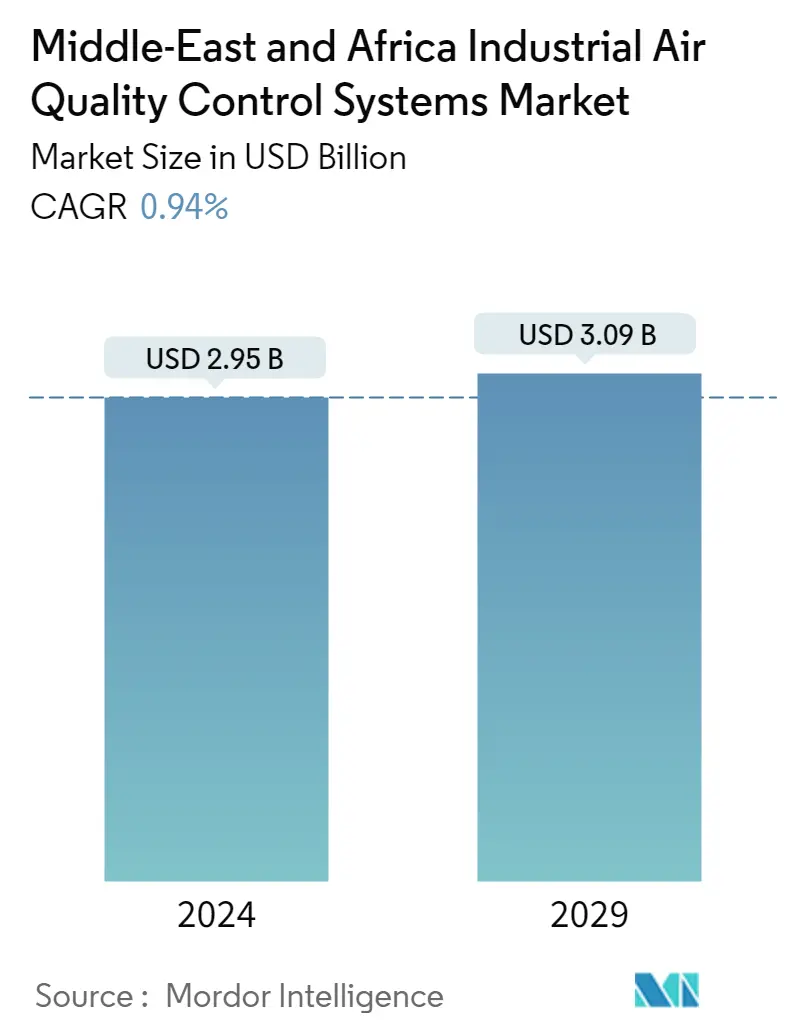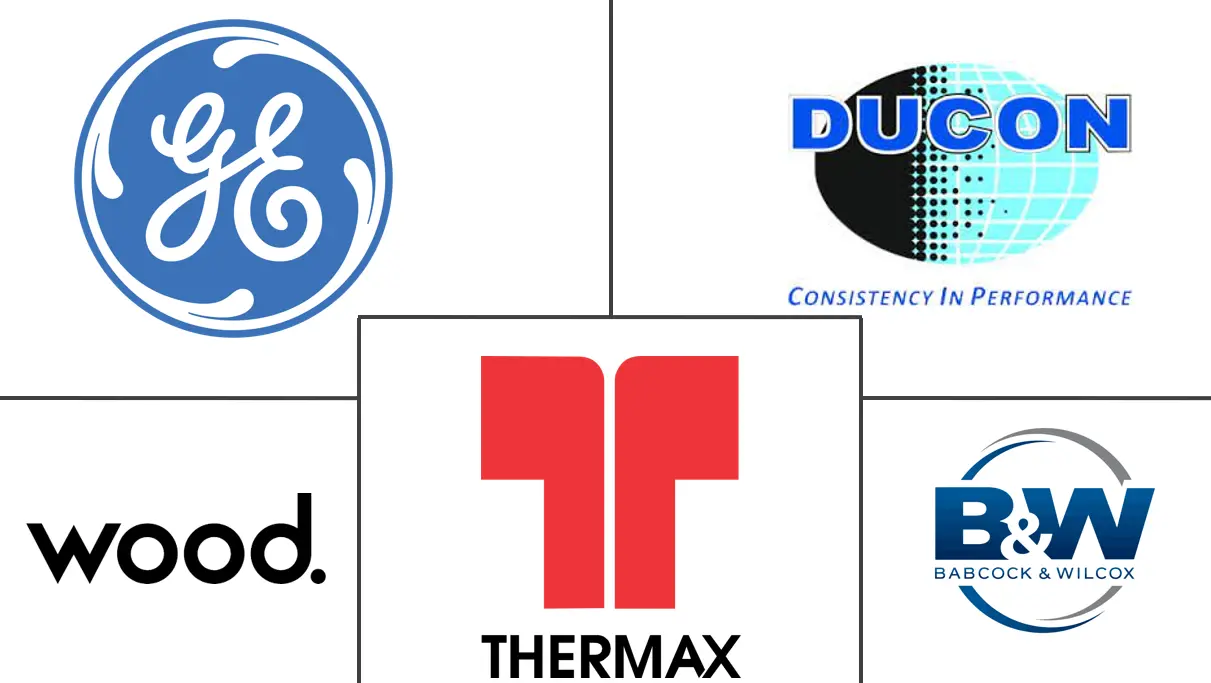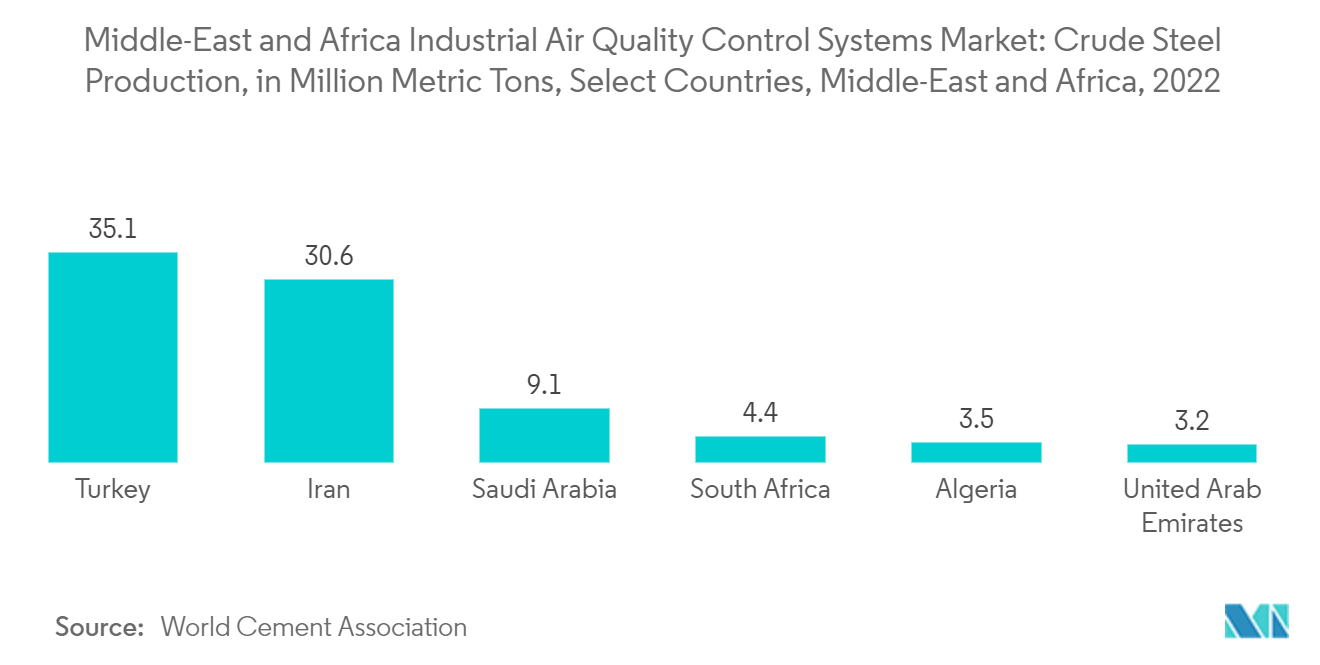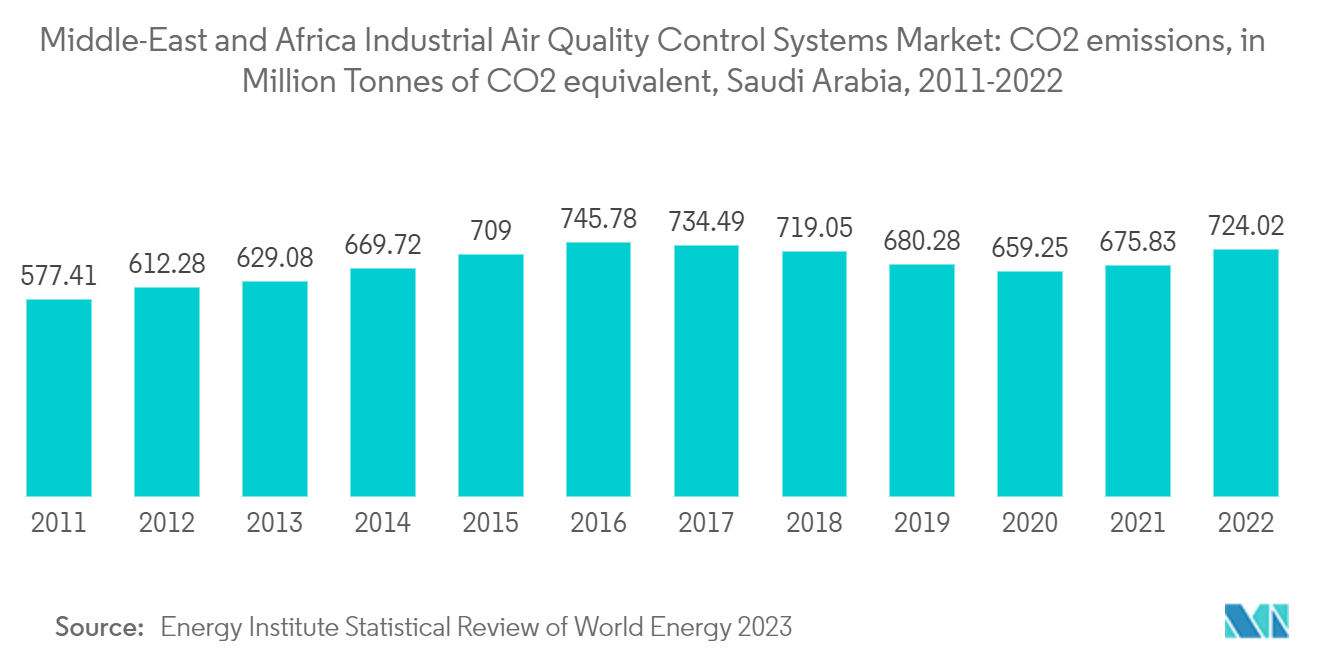MEA Industrial Air Quality Control Systems Market Size

| Study Period | 2019 - 2029 |
| Base Year For Estimation | 2023 |
| Forecast Data Period | 2024 - 2029 |
| Market Size (2024) | USD 2.95 Billion |
| Market Size (2029) | USD 3.09 Billion |
| CAGR (2024 - 2029) | 0.94 % |
| Market Concentration | Low |
Major Players
*Disclaimer: Major Players sorted in no particular order |
MEA Industrial Air Quality Control Systems Market Analysis
The Middle-East and Africa Industrial Air Quality Control Systems Market size is estimated at USD 2.95 billion in 2024, and is expected to reach USD 3.09 billion by 2029, growing at a CAGR of 0.94% during the forecast period (2024-2029).
- Over the longer term, a surge in industrial infrastructure, coupled with air quality issues, is expected to drive the market for air quality control systems in Middle-East and Africa over the forecast period.
- On the other hand, several constitutional barriers and growth in renewable energy usage which is pollution-free are expected to act as major restraints for the market studied.
- Nevertheless, retrofitting of old industrial plants with air quality control system to meet stringent regulatory norms set up by governments across the region is likely to acts as an opportunity in the future.
MEA Industrial Air Quality Control Systems Market Trends
Iron and Steel is Expected to Have Significant Share in the Market
- Steel, produced by either integrated, direct reduced iron, or electric arc furnace route, requires transportation, storage, handling, heating, and transformation of raw materials. All these processes have the potential to generate emissions into the air, primarily in the form of dust (or particulate matter (PM), sulfur dioxide (SO2), and nitrous oxides (NOx). Other emissions generated in small quantities include dioxins and heavy metals, typically attached to dust particles.
- Emissions from iron and steelmaking operations, including cast house floor emissions from blast furnaces, are controlled via secondary dedusting systems (i.e., bag filters, wet scrubbers, ESPs, etc.) with a collection point inside the building.
- All steel plants are subject to environmental regulation, which sets the requirements to restrict emissions into the air. A large portion of modern life is comprised of steel. Infrastructure, buildings, machinery, electrical equipment, automobiles, and various products, from cookware to furniture, require large amounts of iron and steel. The steel demand is estimated to increase by five times by 2050.
- According to the World Steel Association statistics, as of 2022, the crude steel production in the region is mainly dominated by countries like Turkey, Iran, Saudi Arabia, South Africa, Algeria, and the United Arab Emirates, amongst others.
- The Middle East and Africa region has a very high potential for steel production due to the availability of high-grade iron ore. Additionally, in recent years steel production in the area has witnessed significant growth, mainly driven by increasing investments in the sector, especially in the Middle East and North Africa.
- In May 2022, ArcelorMittal signed a non-binding Memorandum of Understanding with SNIM, an iron ore mining company based in Mauritania, to evaluate an opportunity to jointly develop a pelletization plant and a direct reduced iron production plant in Mauritania.
- In September 2022, Saudi Arabia announced that it intends to implement three steel production projects worth USD 9.32 billion with a total production capacity of 6.2 million tons annually. In the same month, Essar Group announced it is looking to invest USD 4 billion in setting up an integrated flat steelworks plant in the country. The plant will have a steel production capacity of 4 million tonnes annually and will be completed by 2025.
- Considering the developments and investments in the steel and iron industry in the region, the demand for industrial air quality control systems is expected to witness significant growth during the forecast period.

Saudi Arabia to Dominate the Market
- Due to the significant growth in its power generation, cement, oil & gas, metal, and other sectors, Saudi Arabia is likely to be one of the largest and fastest-growing markets for industrial air quality control systems. The market is expected to grow at a similar rate during the forecast period, supporting the market growth, as air quality control systems (AQCS) are crucial to these industries.
- Saudi Arabia is one of the largest polluters in the region, with CO2 emissions amounting to approximately 724 million tonnes of CO2 equivalent in 2022. The country is one of the largest producers of CO2 emissions per capita worldwide, at about 19 metric tons per person.
- A significant share of power generated from fossil fuels, such as oil and gas, paving the way for more advanced technologies, such as air quality control systems, to be implemented. In 2022, Saudi Arabia's power generation was dominated by fossil fuels, which account for approximately 99.8% of the electricity generated, followed by non-hydro renewable sources (~0.2%).
- Further, the country continues to invest in fossil fuel-based power projects, which are expected to support the demand for the IAQCS market. For instance, in September 2022, South Korean company Doosan Enerbility was awarded a contract to construct a combined heat and power plant in Saudi Arabia valued at USD 383 million. Upon completion of the construction work scheduled for 2025, the plant will generate 320 MWs of electricity and 314 tons per hour of steam to supply electricity and heat to the Jafurah gas field.
- Further, the rapid growth of the oil & gas, mining, and metal sectors has resulted in a massive increase in the levels of pollutants in the air. Accordingly, the adoption of industrial air quality control systems (IAQCS) is anticipated.
- The Iron and Steel industry is another significant contributor to air pollution. Steel mainly requires coal for energy, so considerable emissions are caused by coal combustion. Steel plants emit air pollutants, such as particulate matter (PM2. 5 and PM10), carbon dioxide, sulfur oxides, nitrogen oxides, carbon monoxide, etc. hence, being a potential end-user for the industrial air quality control systems (IAQCS) in Saudi Arabia.
- According to World Steel Association, in 2022, steel production in Saudi Arabia was approximately 9.1 million, an increase of 4.5% from the previous year. In September 2022, according to the minister of investment, In Saudi Arabia, the iron and steel industry is well positioned for the transition to green and sustainable products due to its technology options, such as low-cost electricity and natural gas, and government programs, such as the Saudi Green Initiative.
- Further, the country has been constructing new refineries and petrochemical complexes. For instance, in December 2022, Saudi Arabian Oil Company and TotalEnergies reached a final investment decision on constructing a world-scale petrochemical facility. The "Amiral" complex is going to be operated, owned, and integrated with the existing Saudi Aramco Total Refining and Petrochemical Co. (SATORP) refinery located on Saudi Arabia's eastern coast, Jubail. With the construction of the petrochemical facility, SATORP will be able to convert its refinery off-gases, naphtha, ethane, and natural gasoline supplied by Aramco into higher-value chemicals, thus supporting Aramco's liquids-to-chemicals strategy. As part of the complex, there will be a mixed feed cracker capable of producing 1.65 million tons of ethylene annually, a first of its kind in the region that will be integrated with a refinery.
- Considering the current investments in the various industries and the increased growth of its value chain in South Africa, the manufacturing sector is critical to the growth of the country's industrial air quality control systems.

MEA Industrial Air Quality Control Systems Industry Overview
The Middle-East and Africa industrial air quality control systems market is fragmented. some of the key players (in no particular order) include Alfa Laval AB, Aircure, CFW Environmental, Pure Air Solutions, and ERG Group, among others.
CFW Environmental’s portfolio of air pollution control systems is based on a range of technologies to comply with the numerous industrial application requirements and specific attributes. Furthermore, the company provides comprehensive services, ranging from first inquiry to after-sales service. It also focused on adopting international best practices in designing and manufacturing air pollution control systems. To remain sustainable in the global market, the products are constantly enhanced by evaluating customers' requirements through market research and innovative product development.
MEA Industrial Air Quality Control Systems Market Leaders
-
Alfa Laval AB
-
Aircure
-
CFW Environmental
-
Pure Air Solutions
-
ERG Group
*Disclaimer: Major Players sorted in no particular order

MEA Industrial Air Quality Control Systems Market News
- In December 2022, Khalifa University of Science and Technology joined forces to find local applications for Levidian Nanosystems' carbon reduction LOOP technology. The RIC-2D at Khalifa University and Zero Carbon Ventures has built a technology facility at the Arzanah Complex on the university's Sas Al Nakhl (SAN) Campus in Abu Dhabi. The system's input and outputs will be studied to create applications for various waste gas blends, such as those used in the oil and gas industry, agriculture, landfills, and wastewater treatment plants.
- In March 2022, Gaussian Robotics and Inc Robotics, one of Gaussian's distributor partners in Saudi Arabia and the United Arab Emirates, exhibited Gaussian's cleaning robot products at The Big 5 Saudi trade expo. The portfolio on display is one of the world's most comprehensive commercial cleaning robots, with models such as the Vacuum 40, Scrubber 50, Crystallizer 60, Scrubber 75, and Sweeper 111.
MEA Industrial Air Quality Control Systems Market Report - Table of Contents
1. INTRODUCTION
1.1 Scope of the Study
1.2 Market Definition
1.3 Study Assumptions
2. EXECUTIVE SUMMARY
3. RESEARCH METHODOLOGY
4. MARKET OVERVIEW
4.1 Introduction
4.2 Market Size and Demand Forecast in USD, till 2028
4.3 Recent Trends and Developments
4.4 Government Policies and Regulations
4.5 Market Dynamics
4.5.1 Drivers
4.5.1.1 Demand from the Downstream Industry
4.5.2 Restraints
4.5.2.1 Adoption of Renewable and Clean Energy Sources
4.6 Supply Chain Analysis
4.7 Porter's Five Forces Analysis
4.7.1 Bargaining Power of Suppliers
4.7.2 Bargaining Power of Consumers
4.7.3 Threat of New Entrants
4.7.4 Threat of Substitute Products and Services
4.7.5 Intensity of Competitive Rivalry
5. MARKET SEGMENTATION
5.1 Type
5.1.1 Electrostatic Precipitators (ESP)
5.1.2 Flue Gas Desulfurization (FGD) and Scrubbers
5.1.3 Selective Catalytic Reduction (SCR)
5.1.4 Fabric Filters
5.1.5 Others
5.2 Application
5.2.1 Power Generation Industry
5.2.2 Cement Industry
5.2.3 Chemicals and Fertilizers
5.2.4 Iron and Steel Industry
5.2.5 Automotive Industry
5.2.6 Oil & Gas Industry
5.2.7 Other Applications
5.3 Emissions
5.3.1 Nitrogen Oxides (NOX)
5.3.2 Sulphur Oxide (SO2)
5.3.3 Particulate Matter (PM)
5.4 Geography
5.4.1 Saudi Arabia
5.4.2 South Africa
5.4.3 Algeria
5.4.4 Rest of Middle East and Africa
6. COMPETITIVE LANDSCAPE
6.1 Mergers and Acquisitions, Joint Ventures, Collaborations, and Agreements
6.2 Strategies Adopted by Leading Players
6.3 Company Profiles
6.3.1 Alfa Laval AB
6.3.2 Aircure
6.3.3 CFW Environmental
6.3.4 Pure Air Solutions
6.3.5 The ERG Group
6.3.6 Redecam Group SpA
6.3.7 Donaldson Company Inc.
6.3.8 Durr AG
6.3.9 FLSmidth & Co. A/S
6.3.10 Siloxa Engineering AG
- *List Not Exhaustive
7. MARKET OPPORTUNITIES AND FUTURE TRENDS
7.1 New Technology Air Quality Control System Developments by Various Companies
MEA Industrial Air Quality Control Systems Industry Segmentation
Air Quality Control Systems (AQCS) include control systems that reduce the proportion of pollutants from flue gases emitted from exhausts of power plants and other industries majorly fuelled by fossil fuels.
The Middle-East and Africa industrial air quality control systems market is segmented by type, application, emissions (Qualitative Analysis only), and geography. By type, the market is segmented into electrostatic precipitators (ESP), flue gas desulfurization (FGD) and scrubbers, selective catalytic reduction (SCR), fabric filters, others. By application, the market is segmented into power generation industry, cement industry, chemicals and fertilizers, iron and steel industry, automotive industry, oil & gas industry, and other applications. By emissions (qualitative analysis only), the market is segmented into nitrogen 0xides (NOx), sulphur oxides (SO2), particulate matter (PM). The report also covers the market size and forecasts for industrial air quality control systems market across major countries in the region. For each segment, the market sizing and forecasts have been done based on revenue (USD).
| Type | |
| Electrostatic Precipitators (ESP) | |
| Flue Gas Desulfurization (FGD) and Scrubbers | |
| Selective Catalytic Reduction (SCR) | |
| Fabric Filters | |
| Others |
| Application | |
| Power Generation Industry | |
| Cement Industry | |
| Chemicals and Fertilizers | |
| Iron and Steel Industry | |
| Automotive Industry | |
| Oil & Gas Industry | |
| Other Applications |
| Emissions | |
| Nitrogen Oxides (NOX) | |
| Sulphur Oxide (SO2) | |
| Particulate Matter (PM) |
| Geography | |
| Saudi Arabia | |
| South Africa | |
| Algeria | |
| Rest of Middle East and Africa |
MEA Industrial Air Quality Control Systems Market Research FAQs
How big is the Middle-East and Africa Industrial Air Quality Control Systems Market?
The Middle-East and Africa Industrial Air Quality Control Systems Market size is expected to reach USD 2.95 billion in 2024 and grow at a CAGR of 0.94% to reach USD 3.09 billion by 2029.
What is the current Middle-East and Africa Industrial Air Quality Control Systems Market size?
In 2024, the Middle-East and Africa Industrial Air Quality Control Systems Market size is expected to reach USD 2.95 billion.
Who are the key players in Middle-East and Africa Industrial Air Quality Control Systems Market?
Alfa Laval AB, Aircure, CFW Environmental, Pure Air Solutions and ERG Group are the major companies operating in the Middle-East and Africa Industrial Air Quality Control Systems Market.
What years does this Middle-East and Africa Industrial Air Quality Control Systems Market cover, and what was the market size in 2023?
In 2023, the Middle-East and Africa Industrial Air Quality Control Systems Market size was estimated at USD 2.92 billion. The report covers the Middle-East and Africa Industrial Air Quality Control Systems Market historical market size for years: 2019, 2020, 2021, 2022 and 2023. The report also forecasts the Middle-East and Africa Industrial Air Quality Control Systems Market size for years: 2024, 2025, 2026, 2027, 2028 and 2029.
Middle-East and Africa Industrial Air Quality Control Systems Industry Report
Statistics for the 2024 Middle-East and Africa Industrial Air Quality Control Systems market share, size and revenue growth rate, created by Mordor Intelligence™ Industry Reports. Middle-East and Africa Industrial Air Quality Control Systems analysis includes a market forecast outlook to 2029 and historical overview. Get a sample of this industry analysis as a free report PDF download.



